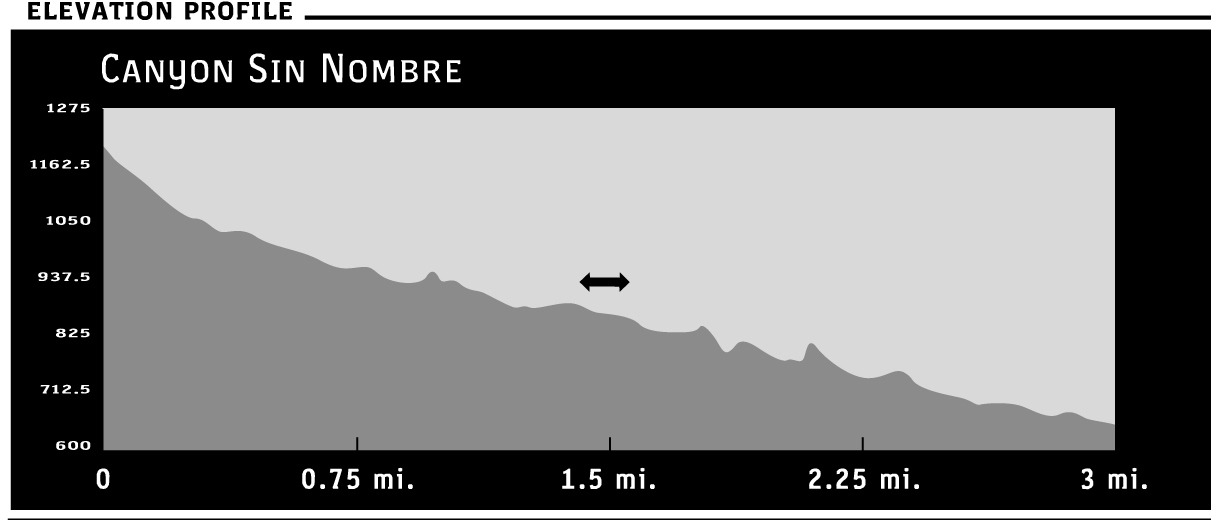32 Canyon Sin Nombre
SCENERY: 
DIFFICULTY: 
TRAIL CONDITION: 
SOLITUDE: 
CHILDREN: 
DISTANCE: 6 miles round trip
HIKING TIME: 2.5–3 hours
OUTSTANDING FEATURES: Sandy wash, slot canyons, smoke trees, and birds
A rather brief jaunt into the canyon cut by floodwaters allows for glimpses of interesting geological characteristics and eroded sandstone formations. Since Canyon Sin Nombre serves as a vehicle throughway to and from Carrizo Creek, you may see four-wheel drives. Traffic may be heavy on weekends (especially in spring), when entire cavalcades forge through the land. You’ll likely also see people camping in Canyon Sin Nombre.
Directions: From Interstate 8E, take the Ocotillo Imperial Highway exit and head northwest on County Rouse S2 (the Great Overland Route of 1849). Drive 12.8 miles to the Canyon Sin Nombre turnout parking area on the right. As an alternative, where CA 78 meets CR S2, head south on CR S2 for approximately 32 miles. En route, you’ll see the sign marking your entrance into Anza-Borrego Desert State Park at approximately 4.4 miles. After 21 miles, CR S2 veers left (a side road goes straight here, so pay attention). The Canyon Sin Nombre turnoff is on the left.
| GPS Coordinates | 32 CANYON SIN NOMBRE | |
| UTM Zone (WGS84) | 11S | |
| Easting | 577669 | |
| Northing | 3632779 | |
| Latitude–Longitude | N 32º 49’ 49.0898” | |
| W 116º 10’ 12.5874” |


 From the parking turnoff, head down the wide, well-trodden vehicle route (soft sand) that moves northeast. Gravity is on your side for nearly the whole first mile, but don’t go too fast to smell the proverbial roses. Allow the spindly, red-bloomed ocotillos, the stout barrel cactus, and the soft calls of flitting birds to transform your nature trek into magic.
From the parking turnoff, head down the wide, well-trodden vehicle route (soft sand) that moves northeast. Gravity is on your side for nearly the whole first mile, but don’t go too fast to smell the proverbial roses. Allow the spindly, red-bloomed ocotillos, the stout barrel cactus, and the soft calls of flitting birds to transform your nature trek into magic.
At 1 mile, you’ll turn left into the canyon opening, almost immediately wowed by the layered walls of metamorphic rock. The stone forms a rather narrow corridor of sorts, widening out after approximately 0.25 miles.
In spring, notice the pale-purple aster flowers cascading down the canyon walls. Gray-green smoke trees are also prevalent. Watch for another interesting form of vegetation found in Canyon Sin Nombre—the stalked puffball. It is the desert’s adaptation to similar fungi from cooler climates. The stalk holds the elongated oval ball up off the hot desert sand, protecting the spores inside from overheating. Under opportune conditions, the ball bursts, releasing an inky cloud of fertile spores on the wind.
At about 1.5 miles, a narrow slot canyon opens on the west side. If you have the time and energy, use the side route to explore, marveling at the slots with towering walls through which you’ll squeeze.
The canyon ends, opening into flat wash land, at around 2.5 miles. This is a good turnaround point for a short day hike.